Air Pollution Inequality and Its Sources in SO2 and NOX Emissions among Chinese Provinces from 2006 to 2015
Abstract
:1. Introduction
2. Literature Review
Air Pollution in China
3. Data and Methods
3.1. Driving Factors behind SO2 and NOX Emissions in China
3.1.1. Economic Disparity and SO2 Emission
3.1.2. Urban Development Disparity and NOX Emission
3.2. Data Source
3.3. The Empirical Methodology
4. Results and Discussion
4.1. SO2 Emission Inequality
4.2. NOX Emission Inequality
5. Conclusions and Policy Implications
Acknowledgments
Author Contributions
Conflicts of Interest
Abbreviations
| SO2 | Sulfur dioxide |
| NOX | Nitrogen oxides |
| FYP | Five-Year Plan |
| NBS | National Bureau of Statistics of China |
| EKC | Environmental Kuznets curve |
Appendix A. Supplementary Figures
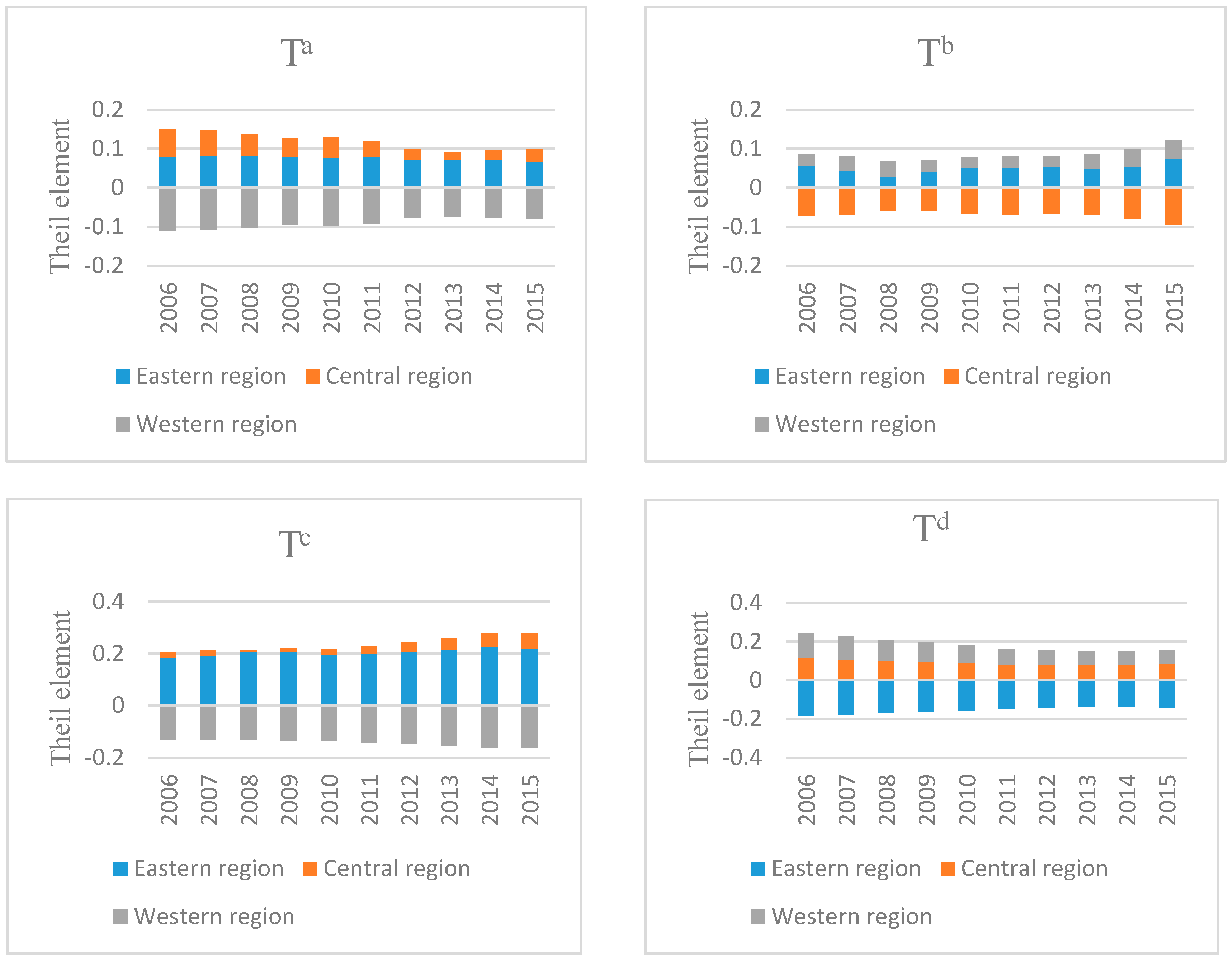

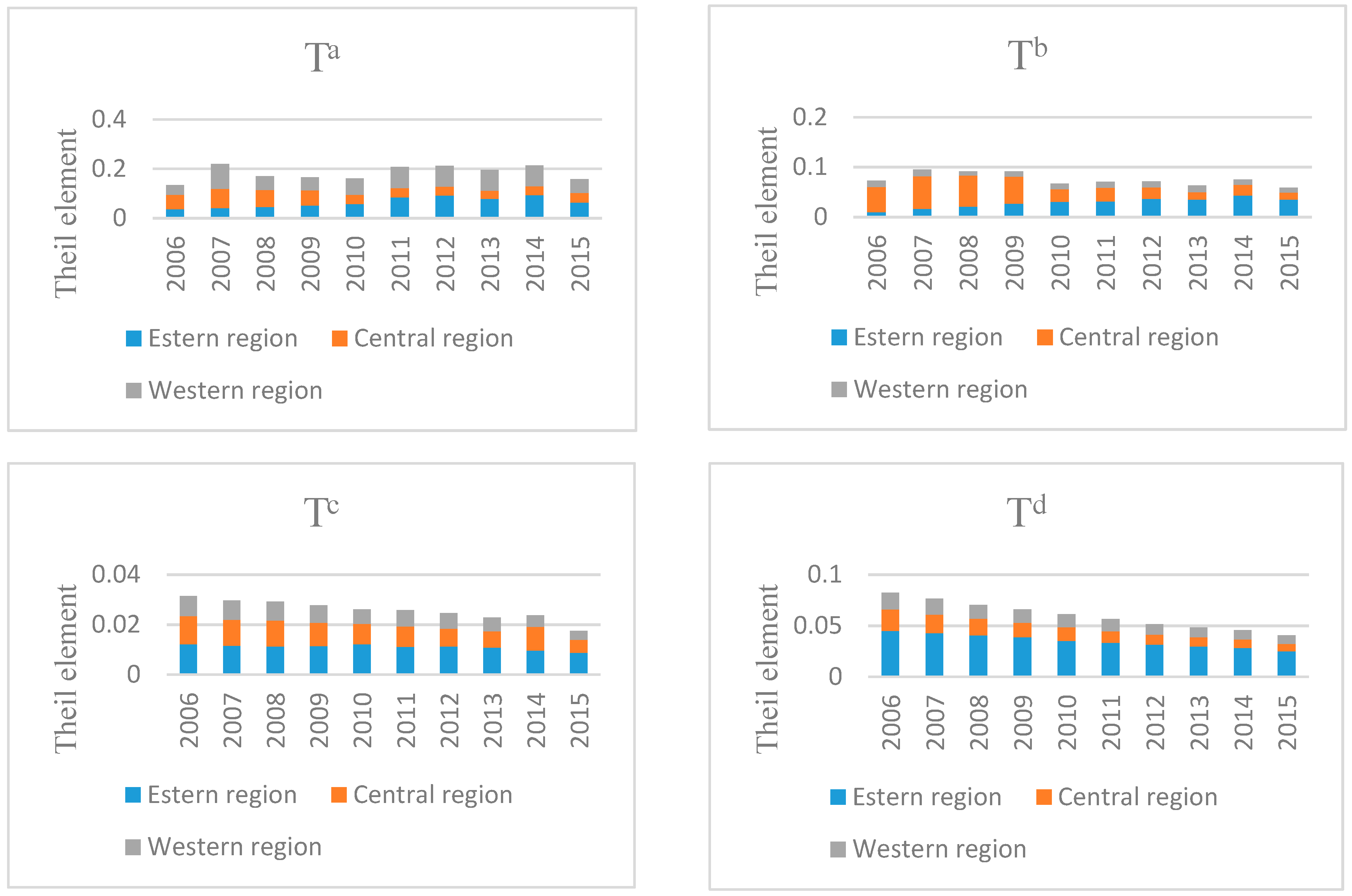
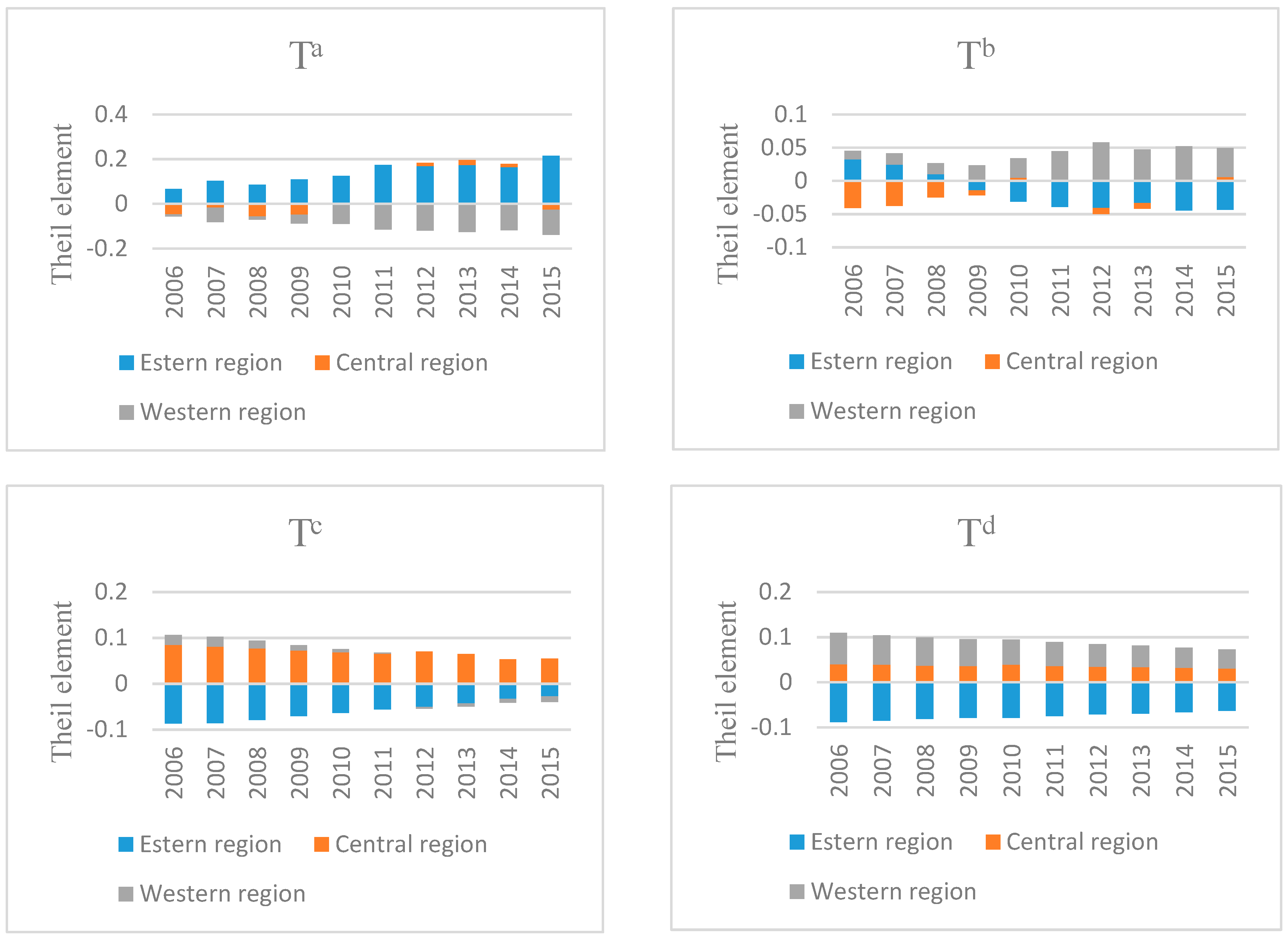
References
- Clean Air Alliance of China (CAAC). “Twelfth Five-Year Plan” on Air Pollution Prevention and Control in Key Regions (China Clean Air Policy Briefings No. 1); English Translation; Secretariat for Clean Air Alliance of China: Beijing, China, 2013; Available online: http://www.ewp.rpi.edu/hartford/~ernesto/F2013/AWPPCE/AdditionalReadings/Air/China2013AirPollutionPreventionControl.pdf (accessed on 14 June 2017).
- Clean Air Alliance of China (CAAC). China Air Quality Management Assessment Report 2015; Secretariat for Clean Air Alliance of China: Beijing, China, 2015; Available online: file:///C:/Users/moh/Downloads/China+Air+Quality+Management+Assessment+Report+%25282015%2529+English+version.pdf (accessed on 14 June 2017).
- Fu, L.; Wan, W.; Zhang, W.; Cheng, H. China Air 2016 Air Pollution Prevention and Control Progress in Chinese Cities. 2016. Available online: http://cleanairasia.org/wp-content/uploads/2016/08/China-Air-2016-Report-Full.pdf (accessed on 14 June 2017).
- Zhao, X.; Zhang, S.; Fan, C. Environmental externality and inequality in China: Current Status and future choices. Environ. Pollut. 2014, 190, 176–179. [Google Scholar] [CrossRef] [PubMed]
- Zwickl, K.; Ash, M.; Boyce, J.K. Regional variation in environmental inequality: Industrial air toxics exposure in U.S. cities. Ecol. Econ. 2014, 107, 494–509. [Google Scholar] [CrossRef]
- Ard, K. Trends in exposure to industrial air toxins for different racial and socioeconomic groups: A spatial and temporal examination of environmental inequality in the U.S. from 1995 to 2004. Soc. Sci. Res. 2015, 53, 375–390. [Google Scholar] [CrossRef] [PubMed]
- Boyce, J.K.; Zwickl, K.; Ash, M. Measuring environmental inequality. Ecol. Econ. 2016, 124, 114–123. [Google Scholar] [CrossRef]
- Yu, H.; Stuart, A.L. Exposure and inequality for select urban air pollutants in the Tampa Bay area. Sci. Total Environ. 2016, 551–552, 474–483. [Google Scholar] [CrossRef] [PubMed]
- Goodman, A.; Wilkinson, P.; Stafford, M.; Tonne, C. Characterising socio-economic inequalities in exposure to air pollution: A comparison of socio-economic markers and scales of measurement. Health Place 2011, 17, 767–774. [Google Scholar] [CrossRef] [PubMed]
- Germani, A.R.; Morone, P.; Testa, G. Environmental justice and air pollution: A case study on Italian provinces. Ecol. Econ. 2014, 106, 69–82. [Google Scholar] [CrossRef] [Green Version]
- Padilla, C.M.; Kihal-Talantikite, W.; Vieira, V.M.; Rossello, P.; Nir, G.L.; Zmirou-Navier, D.; Deguen, S. Air quality and social deprivation in four French metropolitan areas? A localized spatio-temporal environmental inequality analysis. Environ. Res. 2014, 134, 315–324. [Google Scholar] [CrossRef] [PubMed]
- Fecht, D.; Fischer, P.; Fortunato, L.; Hoek, G.; de Hoogh, K.; Marra, M.; Hansell, A. Associations between air pollution and socioeconomic characteristics, ethnicity and age profile of neighbourhoods in England and the Netherlands. Environ. Pollut. 2015, 198, 201–210. [Google Scholar] [CrossRef] [PubMed]
- Rodríguez-rosa, M.; Gallego-álvarez, I. Are Social, Economic and Environmental Well-Being Equally Important in all Countries around the World? A Study by Income. Soc. Indic. Res. 2017. [Google Scholar] [CrossRef]
- Kaya, Y. Impact of Carbon Dioxide Emission Control on GNP Growth: Interpretation of Proposed Scenarios; IPCC: Paris, France, 1989. [Google Scholar]
- Rafaj, P.; Amann, M.; Siri, J.; Wuester, H. Changes in European greenhouse gas and air pollutant emissions 1960–2010: Decomposition of determining factors. Clim. Chang. 2014, 124, 477–504. [Google Scholar] [CrossRef]
- Duro, J.A.; Padilla, E. International inequalities in per capita CO2 emissions: A decomposition methodology by Kaya factors. Energy Econ. 2006, 28, 170–187. [Google Scholar] [CrossRef]
- Remuzgo, L.; Sarabia, J.M. International inequality in CO2 emissions: A new factorial decomposition based on Kaya factors. Environ. Sci. Policy 2015, 54, 15–24. [Google Scholar] [CrossRef]
- Ministry of Environmental Protection of the People’s Republic of China (MEP). Report on the State of the Environment in China; Ministry of Environmental Protection of the People’s Republic of China: Beijing, China, 2015. Available online: http://english.sepa.gov.cn/Resources/Reports/soe/Report/201706/P020170614504782926467.pdf (accessed on 16 November 2017).
- Theil, H. Economics and Information Theory; North-Holland Pub. Co.: Amsterdam, The Netherlands, 1967. [Google Scholar]
- Klimont, Z.; Smith, S.J.; Cofala, J. The last decade of global anthropogenic sulfur dioxide: 2000–2011 emissions. Environ. Res. Lett. 2013, 8, 14003. [Google Scholar] [CrossRef]
- Amann, M.; Klimont, Z.; Wagner, F. Regional and Global Emissions of Air Pollutants: Recent Trends and Future Scenarios. Annu. Rev. Environ. Resour. 2013, 38, 31–55. [Google Scholar] [CrossRef]
- Zhao, B.; Wang, S.; Wang, J.; Fu, J.S.; Liu, T.; Xu, J.; Hao, J. Impact of national NOX and SO2 control policies on particulate matter pollution in China. Atmos. Environ. 2013, 77, 453–463. [Google Scholar] [CrossRef]
- Lin, H.; Liu, T.; Xiao, J.; Zeng, W.; Li, X.; Guo, L.; Ma, W. Mortality burden of ambient fine particulate air pollution in six Chinese cities: Results from the Pearl River Delta study. Environ. Int. 2016, 96, 91–97. [Google Scholar] [CrossRef] [PubMed]
- Xia, Y.; Guan, D.; Jiang, X.; Peng, L.; Schroeder, H.; Zhang, Q. Assessment of socioeconomic costs to Chinas air pollution. Atmos. Environ. 2016, 139, 147–156. [Google Scholar] [CrossRef]
- Buehn, A.; Farzanegan, M.R. Hold your breath: A new index of air pollution. Energy Econ. 2013, 37, 104–113. [Google Scholar] [CrossRef]
- Branis, M.; Linhartova, M. Association between unemployment, income, education level, population size and air pollution in Czech cities: Evidence for environmental inequality? A pilot national scale analysis. Health Place 2012, 18, 1110–1114. [Google Scholar] [CrossRef] [PubMed]
- Schoolman, E.D.; Ma, C. Migration, class and environmental inequality: Exposure to pollution in China’s Jiangsu Province. Ecol. Econ. 2012, 75, 140–151. [Google Scholar] [CrossRef]
- Dong, L.; Dong, H.; Fujita, T.; Geng, Y.; Fujii, M. Cost-effectiveness analysis of China’s Sulfur dioxide control strategy at the regional level: Regional disparity, inequity and future challenges. J. Clean Prod. 2015, 90, 345–359. [Google Scholar] [CrossRef]
- Su, J.G.; Morello-Frosch, R.; Jesdale, B.M.; Kyle, A.D.; Shamasunder, B.; Jerrett, M. An index for assessing demographic inequalities in cumulative environmental hazards with application to Los Angeles, California. Environ. Sci. Technol. 2009, 43, 7626–7634. [Google Scholar] [CrossRef] [PubMed]
- Romero-Lankao, P.; Qin, H.; Borbor-Cordova, M. Exploration of health risks related to air pollution and temperature in three Latin American cities. Soc. Sci. Med. 2013, 83, 110–118. [Google Scholar] [CrossRef] [PubMed]
- Moreno-Jiménez, A.; Cañada-Torrecilla, R.; Vidal-Domínguez, M.J.; Palacios-García, A.; Martínez-Suárez, P. Assessing environmental justice through potential exposure to air pollution: A socio-spatial analysis in Madrid and Barcelona, Spain. Geoforum 2016, 69, 117–131. [Google Scholar] [CrossRef]
- Gu, D.; Wang, Y.; Smeltzer, C.; Liu, Z. Reduction in NOX emission trends over China: Regional and seasonal variations. Environ. Sci. Technol. 2013, 47, 12912–12919. [Google Scholar] [CrossRef] [PubMed]
- Hao, Y.; Zhang, Q.; Zhong, M.; Li, B. Is there convergence in per capita SO2 emissions in China? An empirical study using city-level panel data. J. Clean Prod. 2015, 108, 944–954. [Google Scholar] [CrossRef]
- Lyu, W.; Li, Y.; Guan, D.; Zhao, H.; Zhang, Q.; Liu, Z. Driving forces of Chinese primary air pollution emissions: An index decomposition analysis. J. Clean Prod. 2016, 133, 136–144. [Google Scholar] [CrossRef]
- Kanada, M.; Dong, L.; Fujita, T.; Fujii, M.; Inoue, T.; Hirano, Y.; Geng, Y. Regional disparity and cost-effective SO2 pollution control in China: A case study in 5 mega-cities. Energy Policy 2013, 61, 1322–1331. [Google Scholar] [CrossRef]
- Grossman, G.M.; Krueger, A.B. Environmental Impacts of a North American Free Trade Agreement; Working Paper Series; No. 3914; National Bureau of Economic Research: Cambridge, MA, USA, 1991; pp. 1–57. Available online: http://www.nber.org/papers/w3914.pdf (accessed on 13 June 2017).
- Wang, Y.; Han, R.; Kubota, J. Is there an Environmental Kuznets Curve for SO2 emissions? A semi-parametric panel data analysis for China. Renew. Sustain. Energy Rev. 2016, 54, 1182–1188. [Google Scholar] [CrossRef]
- Llorca, M.; Meunié, A. SO2 emissions and the environmental Kuznets curve: The case of Chinese provinces. J. Chin. Econ. Bus. Stud. 2009, 7, 1–16. [Google Scholar] [CrossRef]
- National Bureau of Statistics of China (NBS). National Data, Annual by Province; National Bureau of Statistics of China: Beijing, China, 2015. Available online: http://data.stats.gov.cn/english/easyquery.htm?cn=E0103 (accessed on 25 December 2016).
- Lu, Z.; Streets, D.G.; Zhang, Q.; Wang, S.; Carmichael, G.R.; Cheng, Y.F.; Tan, Q. Sulfur dioxide emissions in China and sulfur trends in East Asia since 2000. Atmos. Chem. Phys. 2010, 10, 6311–6331. [Google Scholar] [CrossRef]
- Yang, X.; Wang, S.; Zhang, W.; Li, J.; Zou, Y. Impacts of energy consumption, energy structure, and treatment technology on SO2 emissions: A multi-scale LMDI decomposition analysis in China. Appl. Energy 2016, 184, 714–726. [Google Scholar] [CrossRef]
- Qu, Y.; An, J.; He, Y.; Zheng, J. An overview of emissions of SO2 and NOX and the long-range transport of oxidized sulfur and nitrogen pollutants in East Asia. J. Environ. Sci. 2016, 44, 13–25. [Google Scholar] [CrossRef] [PubMed]
- Li, X.; Wu, X.; Zhang, F. A method for analyzing pollution control policies: Application to SO2 emissions in China. Energy Econ. 2015, 49, 451–459. [Google Scholar] [CrossRef]
- Huang, L.; Hu, J.; Chen, M. Impacts of power generation on air quality in China—Part I: An overview. Resour. Conserv. Recycl. 2017, 121, 103–114. [Google Scholar] [CrossRef]
- Van Der A, R.J.; Mijling, B.; Ding, J.; Elissavet Koukouli, M.; Liu, F.; Li, Q.; Theys, N. Cleaning up the air: Effectiveness of air quality policy for SO2 and NOX emissions in China. Atmos. Chem. Phys. 2017, 17, 1775–1789. [Google Scholar] [CrossRef]
- Yang, L.; Li, J. Rebound effect in China: Evidence from the power generation sector. Renew. Sustain. Energy Rev. 2017, 71, 53–62. [Google Scholar] [CrossRef]
- Zhang, Q.; Weili, T.; Yumei, W.; Yingxu, C. External costs from electricity generation of China up to 2030 in energy and abatement scenarios. Energy Policy 2007, 35, 4295–4304. [Google Scholar] [CrossRef]
- Cheng, Y.S.; Wong, W.K.; Woo, C.K. How much have electricity shortages hampered China’s GDP growth? Energy Policy 2013, 55, 369–373. [Google Scholar] [CrossRef]
- Lin, B.; Liu, C. Why is electricity consumption inconsistent with economic growth in China? Energy Policy 2016, 88, 310–316. [Google Scholar] [CrossRef]
- Teixidó-Figueras, J.; Steinberger, J.K.; Krausmann, F.; Haberl, H.; Wiedmann, T.; Peters, G.P.; Kastner, T. International inequality of environmental pressures: Decomposition and comparative analysis. Ecol. Indic. 2016, 62, 163–173. [Google Scholar] [CrossRef]
- Knill, C.; Schulze, K.; Tosun, J. Regulatory policy outputs and impacts: Exploring a complex relationship. Regul. Gov. 2012, 6, 427–444. [Google Scholar] [CrossRef]
- Lung, S.-C.C.; Lee, C.-R.; Hu, S.-C. Inequality of Asian-type neighborhood environmental quality in communities with different urbanization levels. Environ. Sci. Policy 2014, 38, 1–10. [Google Scholar] [CrossRef]
- Liu, J.; Zhu, T. NOX in Chinese Megacities. Disposal of Dangerous Chemicals in Urban Areas and Mega Cities: Role of Oxides and Acids of Nitrogen in Atmospheric Chemistry; Barnes, I., Rudziński, K.J., Eds.; Springer: Dordrecht, The Netherlands, 2013; pp. 249–263. [Google Scholar]
- Wang, S.; Xing, J.; Zhao, B.; Jang, C.; Hao, J. Effectiveness of national air pollution control policies on the air quality in metropolitan areas of China. J. Environ. Sci. 2014, 26, 13–22. [Google Scholar] [CrossRef]
- Wu, Y.; Zhang, S.; Hao, J.; Liu, H.; Wu, X.; Hu, J.; Stevanovic, S. On-road vehicle emissions and their control in China: A review and outlook. Sci. Total Environ. 2017, 574, 332–349. [Google Scholar] [CrossRef] [PubMed]
- Gu, B.; Dong, X.; Peng, C.; Luo, W.; Chang, J.; Ge, Y. The long-term impact of urbanization on nitrogen patterns and dynamics in Shanghai, China. Environ. Pollut. 2012, 171, 30–37. [Google Scholar] [CrossRef] [PubMed]
- Deng, Y.; Chen, C.; Li, Q.; Hu, Q.; Yuan, H.; Li, J.; Li, Y. Measurements of real-world vehicle CO and NOX fleet average emissions in urban tunnels of two cities in China. Atmos. Environ. 2015, 122, 417–426. [Google Scholar] [CrossRef]
- Streets, D.; Waldhoff, S. Present and future emissions of air pollutants in China. Atmos. Environ. 2000, 34, 363–374. [Google Scholar] [CrossRef]
- Zhao, B.; Wang, S.X.; Liu, H.; Xu, J.Y.; Fu, K.; Klimont, Z.; Amann, M. NOX emissions in China: Historical trends and future perspectives. Atmos. Chem. Phys. 2013, 13, 9869–9897. [Google Scholar] [CrossRef] [Green Version]
- Yao, Z.; Wu, B.; Wu, Y.; Cao, X.; Jiang, X. Comparison of NOX emissions from China III and China IV in-use diesel trucks based on on-road measurements. Atmos. Environ. 2015, 123, 1–8. [Google Scholar] [CrossRef]
- Tang, G.; Chao, N.; Wang, Y.; Chen, J. Vehicular emissions in China in 2006 and 2010. J. Environ. Sci. 2016, 48, 179–192. [Google Scholar] [CrossRef] [PubMed]
- Liu, F.; Zhang, Q.; Zheng, B.; Tong, D.; Yan, L.; Zheng, Y.; He, K. Recent reduction in NOX emissions over China: Synthesis of satellite observations and emission inventories. Environ. Res. Lett. 2016, 11, 114002. [Google Scholar] [CrossRef]
- Shi, Y.; Xia, Y.; Lu, B.; Liu, N.; Zhang, L.; Li, S.; Li, W. Emission inventory and trends of NOX for China, 2000–2020. J. Zhejiang Univ.-SCI A 2014, 15, 454–464. [Google Scholar] [CrossRef]
- Ministry of Environmental Protection of the People’s Republic of China (MEP). China Vehicle Emission Control Annual Report; Ministry of Environmental Protection of the People’s Republic of China: Beijing, China, 2010. Available online: http://www.vecc-mep.org.cn/news/e_home_gg/2010engreport.pdf (accessed on 6 June 2017).
- Ministry of Environmental Protection of the People’s Republic of China (MEP). China Vehicle Emission Control Annual Report; Ministry of Environmental Protection of the People’s Republic of China: Beijing, China, 2015. Available online: http://dqhj.mep.gov.cn/jdchjgl/zhgldt/201605/P020160513584304398771.pdf (accessed on 6 June 2017). (In Chinese)
- Ministry of Environmental Protection of the People’s Republic of China (MEP). Annual Report on Environmental Statistics 2006–2014; Ministry of Environmental Protection of the People’s Republic of China: Beijing, China, 2016. Available online: https://wenku.baidu.com/view/441928f458fb770bf68a552d.html?from=search (accessed on 5 May 2017). (In Chinese)
- Ang, B.W.; Zhang, F.Q. A survey of index decomposition analysis in energy and environmental studies. Energy 2000, 25, 1149–1176. [Google Scholar] [CrossRef]
- Ang, B. Decomposition analysis for policymaking in energy. Energy Policy 2004, 32, 1131–1139. [Google Scholar] [CrossRef]
- Bourguignon, F. Decomposable income inequality measures. J. Econom. Soc. 1979, 47, 901–920. [Google Scholar] [CrossRef]
- Padilla, E.; Serrano, A. Inequality in CO2 emissions across countries and its relationship with income inequality: A distributive approach. Energy Policy 2006, 34, 1762–1772. [Google Scholar] [CrossRef]
- Clarke-Sather, A.; Qu, J.; Wang, Q.; Zeng, J.; Li, Y. Carbon inequality at the sub-national scale: A case study of provincial-level inequality in CO2 emissions in China 1997–2007. Energy Policy 2011, 39, 5420–5428. [Google Scholar] [CrossRef]
- Duro, J.A. The international distribution of energy intensities: Some synthetic results. Energy Policy 2015, 83, 257–266. [Google Scholar] [CrossRef]
- Sauter, C.; Grether, J.-M.; Mathys, N.A. Geographical spread of global emissions: Within-country inequalities are large and increasing. Energy Policy 2016, 89, 138–149. [Google Scholar] [CrossRef]
- Duro, J.A.; Teixidó-Figueras, J.; Padilla, E. Empirics of the International Inequality in CO2 Emissions Intensity: Explanatory Factors According to Complementary Decomposition Methodologies. Environ. Resour. Econ. 2016, 63, 57–77. [Google Scholar] [CrossRef]
- Harper, S.; Ruder, E.; Roman, A.H.; Geggel, A.; Nweke, O.; Payne-Sturges, D.; Levy, I.J. Using Inequality Measures to Incorporate Environmental Justice into Regulatory Analyses. Int. J. Environ. Res. Public Health 2013, 10, 4039–4059. [Google Scholar] [CrossRef] [PubMed] [Green Version]
- Zhang, W.; Bao, S. Created unequal: China’s regional pay inequality and its relationship with mega-trend urbanization. Appl. Geogr. 2015, 61, 81–93. [Google Scholar] [CrossRef]
- Padilla, E.; Duro, J.A. Explanatory factors of CO2 per capita emission inequality in the European Union. Energy Policy 2013, 62, 1320–1328. [Google Scholar] [CrossRef]
- Zhao, G.; Guerrero, J.M.; Pei, Y. Marginal generation technology in the Chinese power market towards 2030 based on consequential life cycle assessment. Energies 2016, 9, 788. [Google Scholar] [CrossRef]
- Zhang, C.; Zhao, W. Panel estimation for income inequality and CO2 emissions: A regional analysis in China. Appl. Energy 2014, 136, 382–392. [Google Scholar] [CrossRef]
- Gao, C.; Yin, H.; Ai, N.; Huang, Z. Historical Analysis of SO2 Pollution Control Policies in China. Environ. Manag. 2009, 43, 447–457. [Google Scholar] [CrossRef] [PubMed]
- National People’s Congress of the People’s Republic of China (NPC). Report on the Work of the Government. 2016. Available online: http://www.npc.gov.cn/englishnpc/Speeches/2016-03/18/content_1985677.htm (accessed on 10 June 2017).
- Ding, L.; Liu, C.; Chen, K.; Huang, Y.; Diao, B. Atmospheric pollution reduction effect and regional predicament: An empirical analysis based on the Chinese provincial NOX emissions. J. Environ. Manag. 2017, 196, 178–187. [Google Scholar] [CrossRef] [PubMed]
- Sichuan Provincial People’s Government (SPPG). Report on the Work of the Government. 2016. Available online: http://www.sc.gov.cn/10462/10758/10760/10766/2016/2/23/10370523.shtml (accessed on 12 June 2017).
- Liu, Q.; Wang, Q. Pathways to SO2 emissions reduction in China for 1995–2010: Based on decomposition analysis. Environ. Sci. Policy 2013, 33, 405–415. [Google Scholar] [CrossRef]
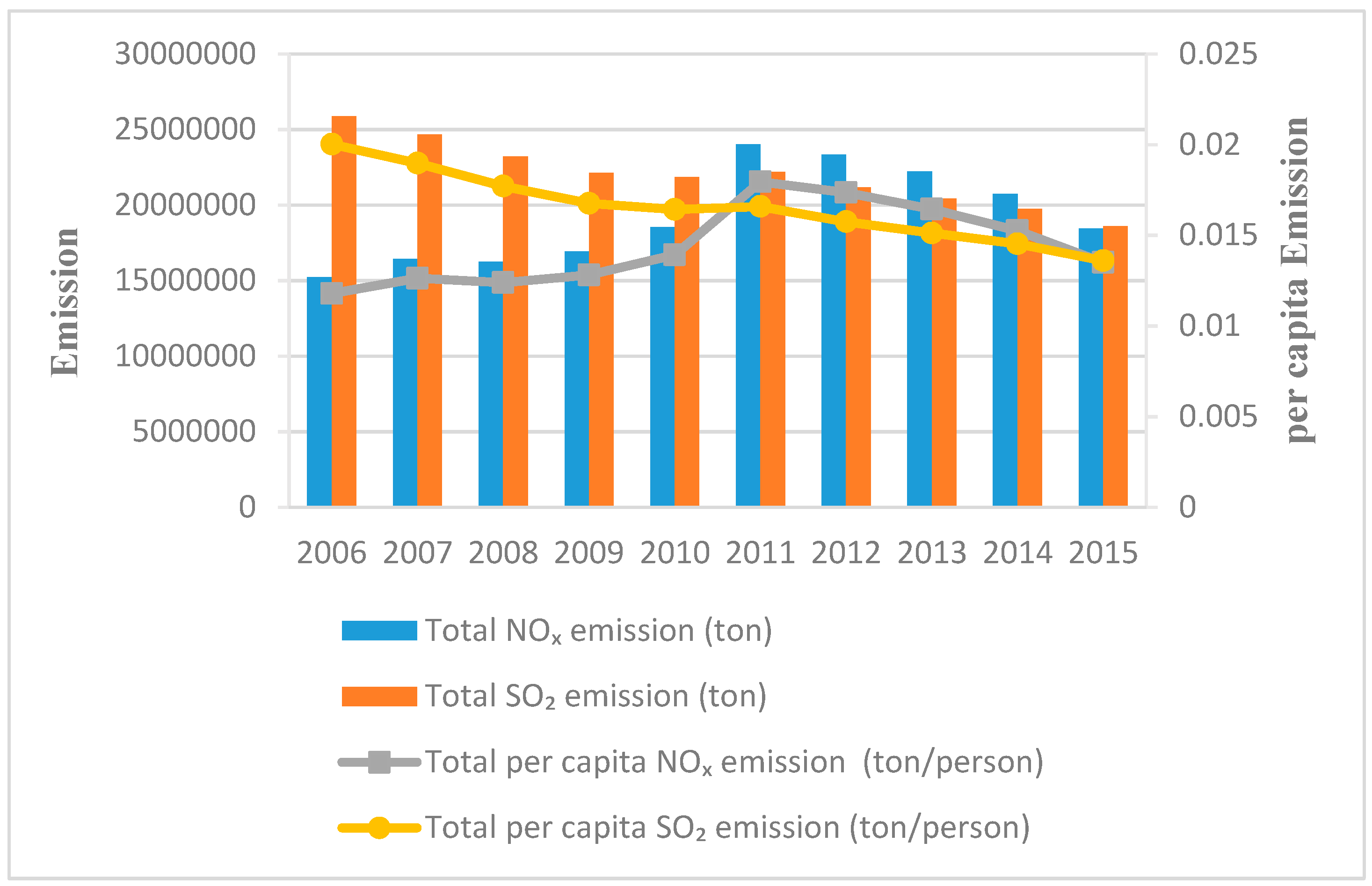
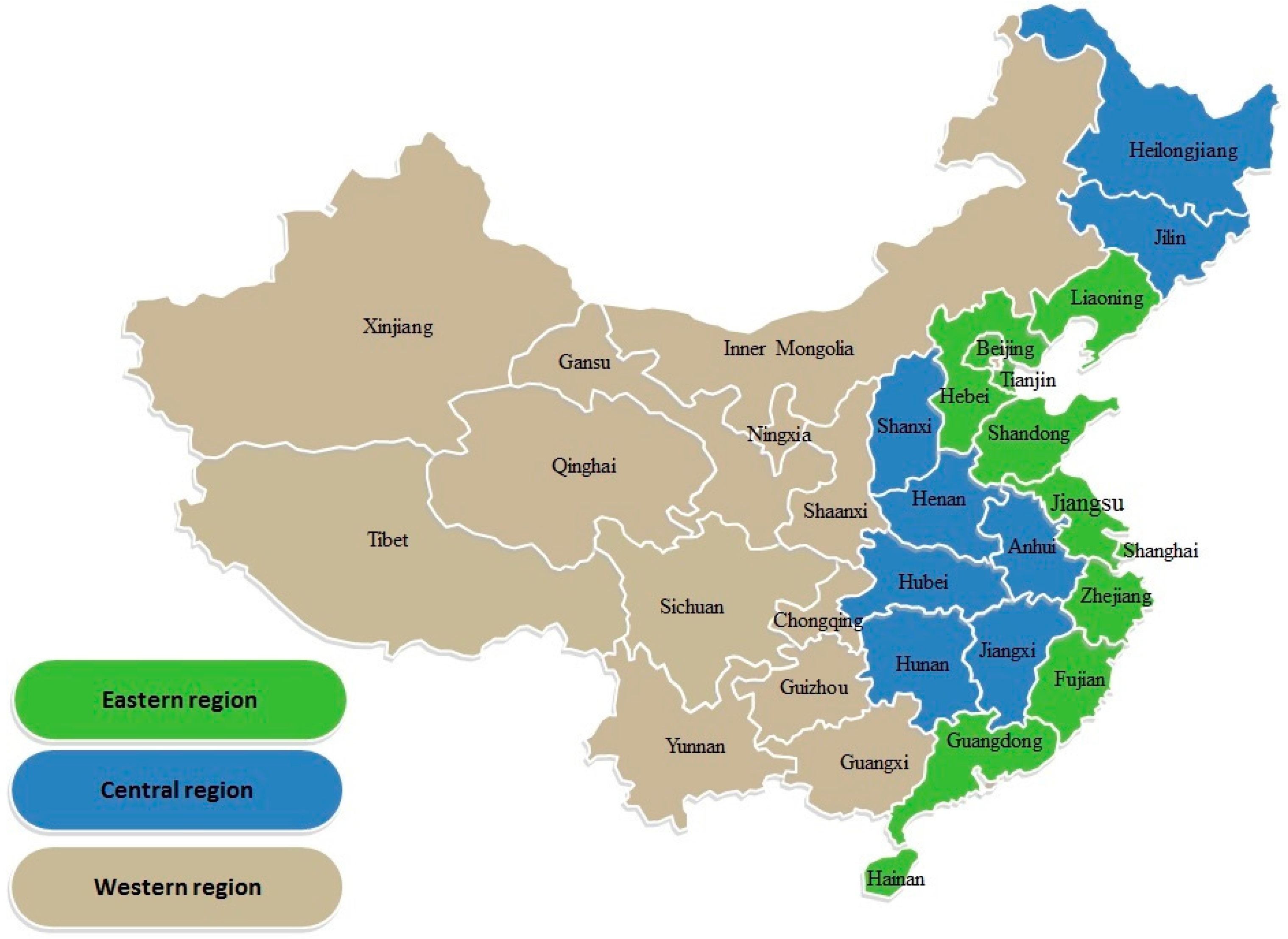
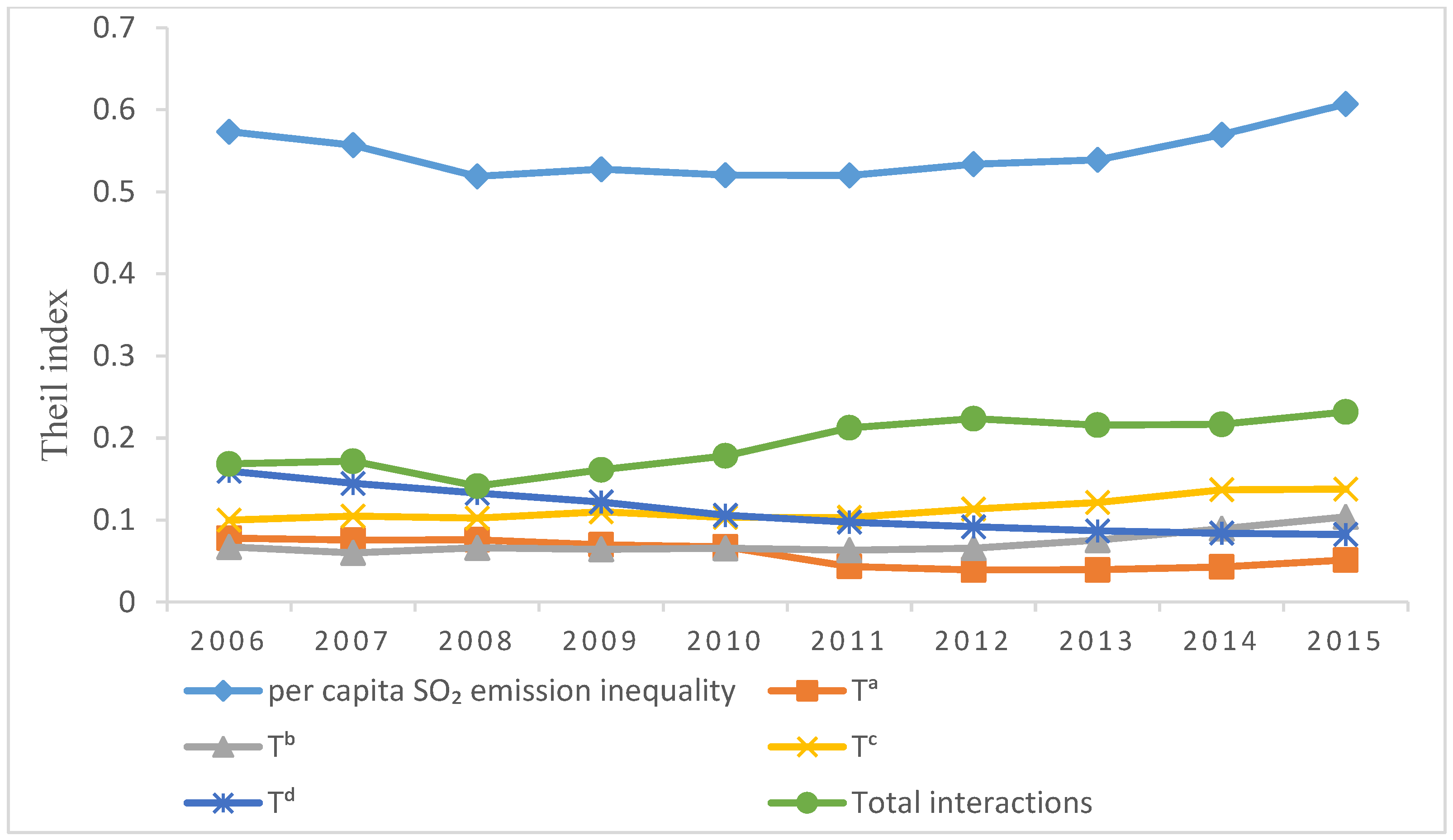

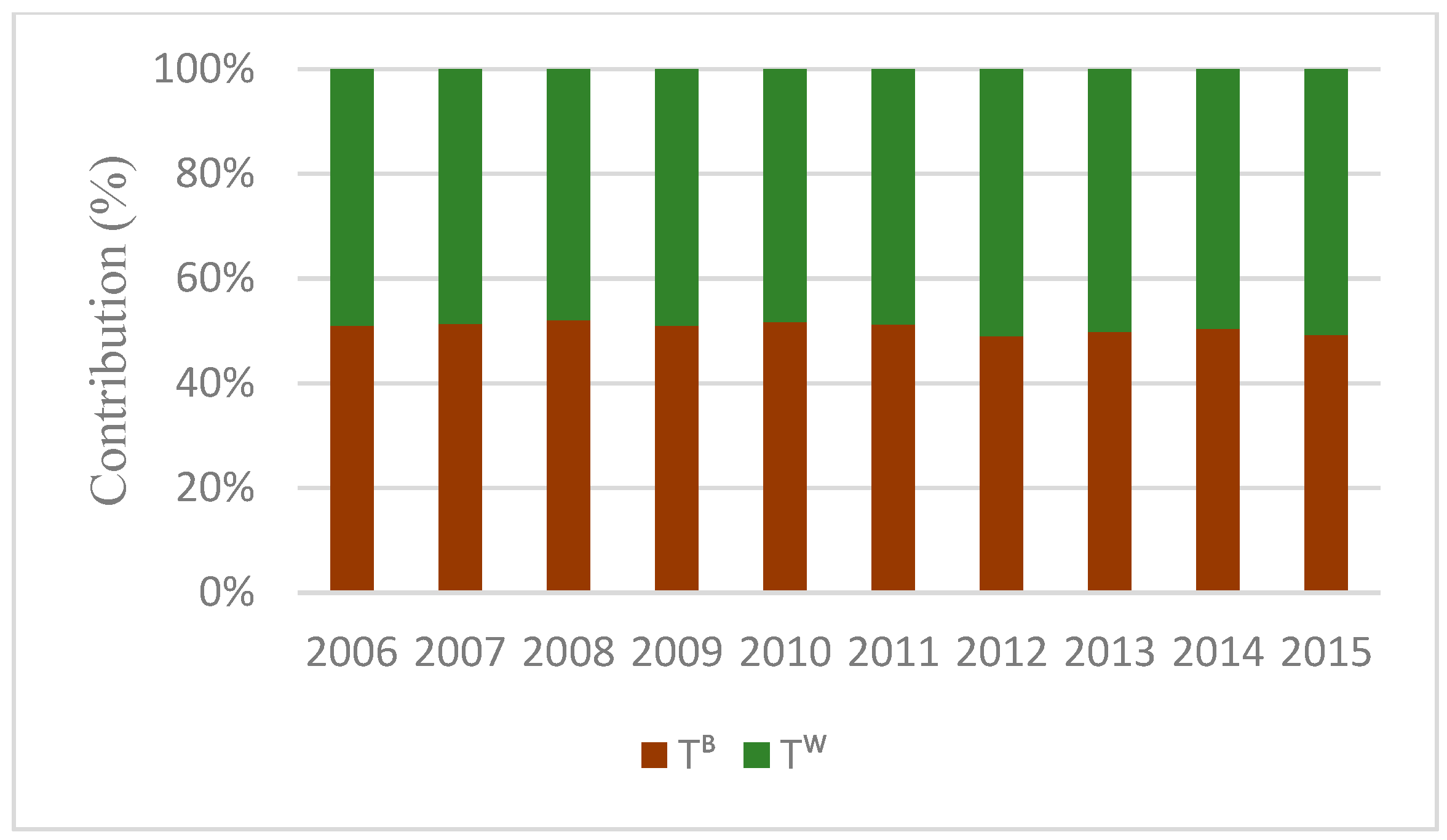


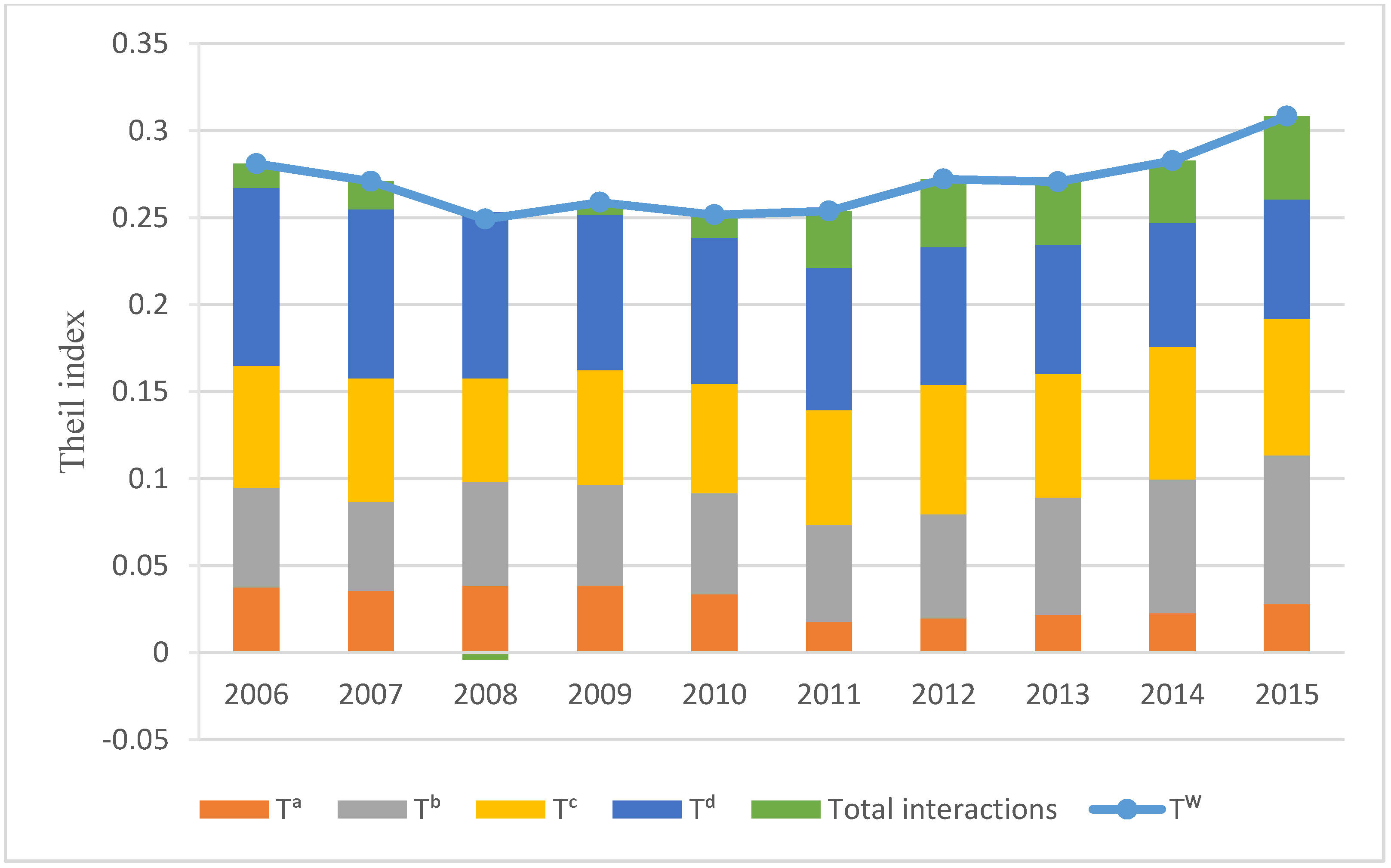
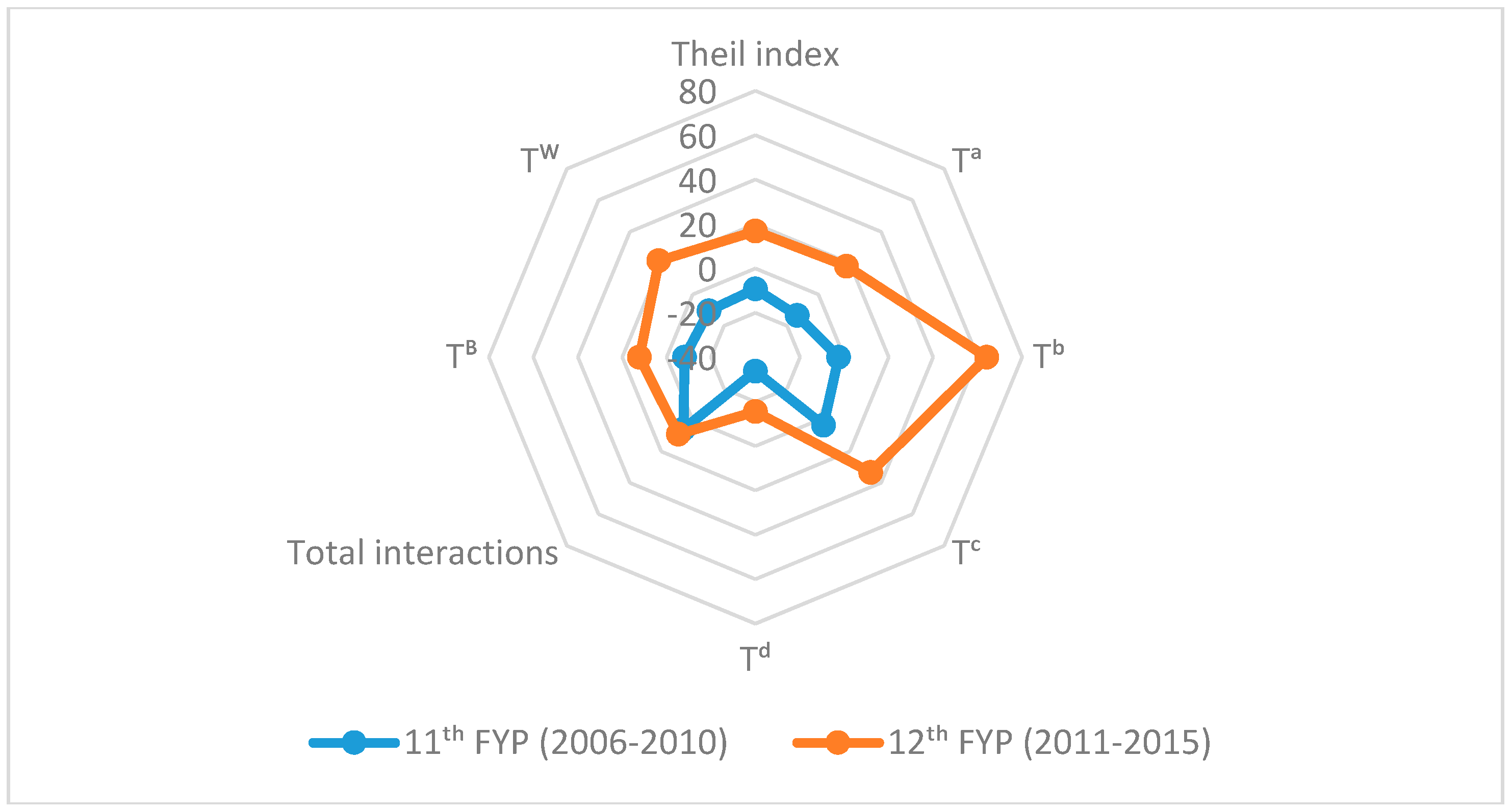
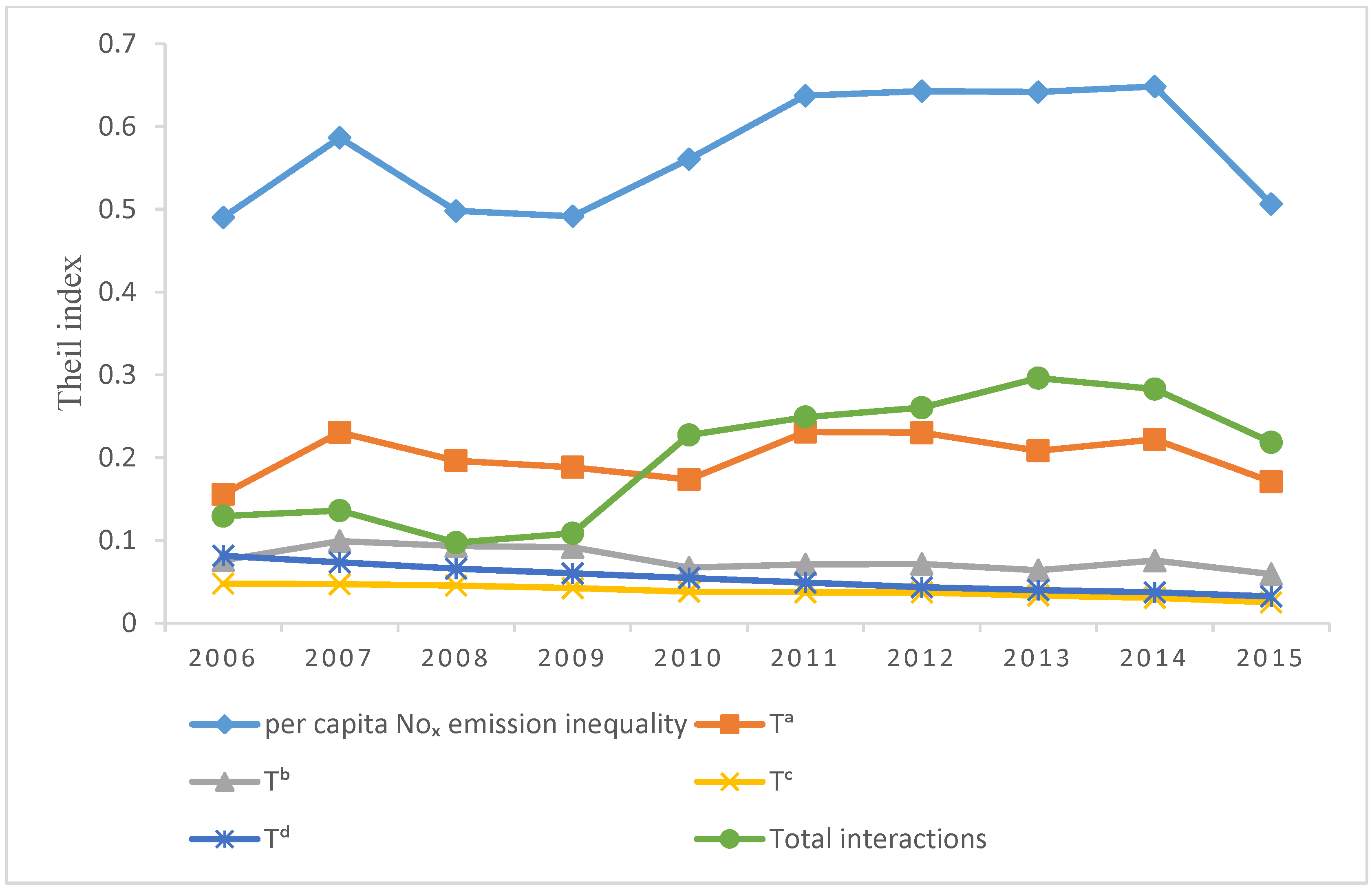
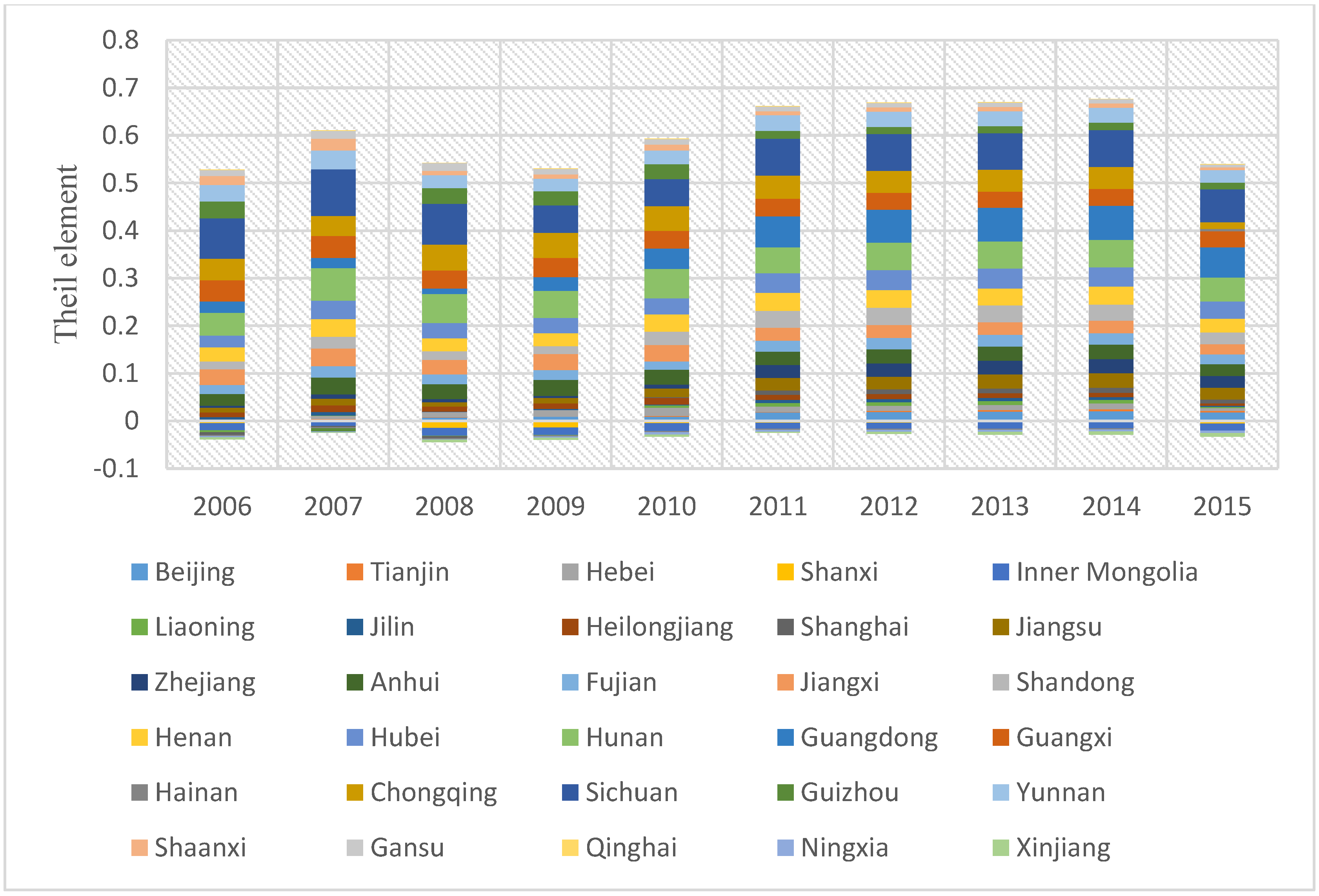
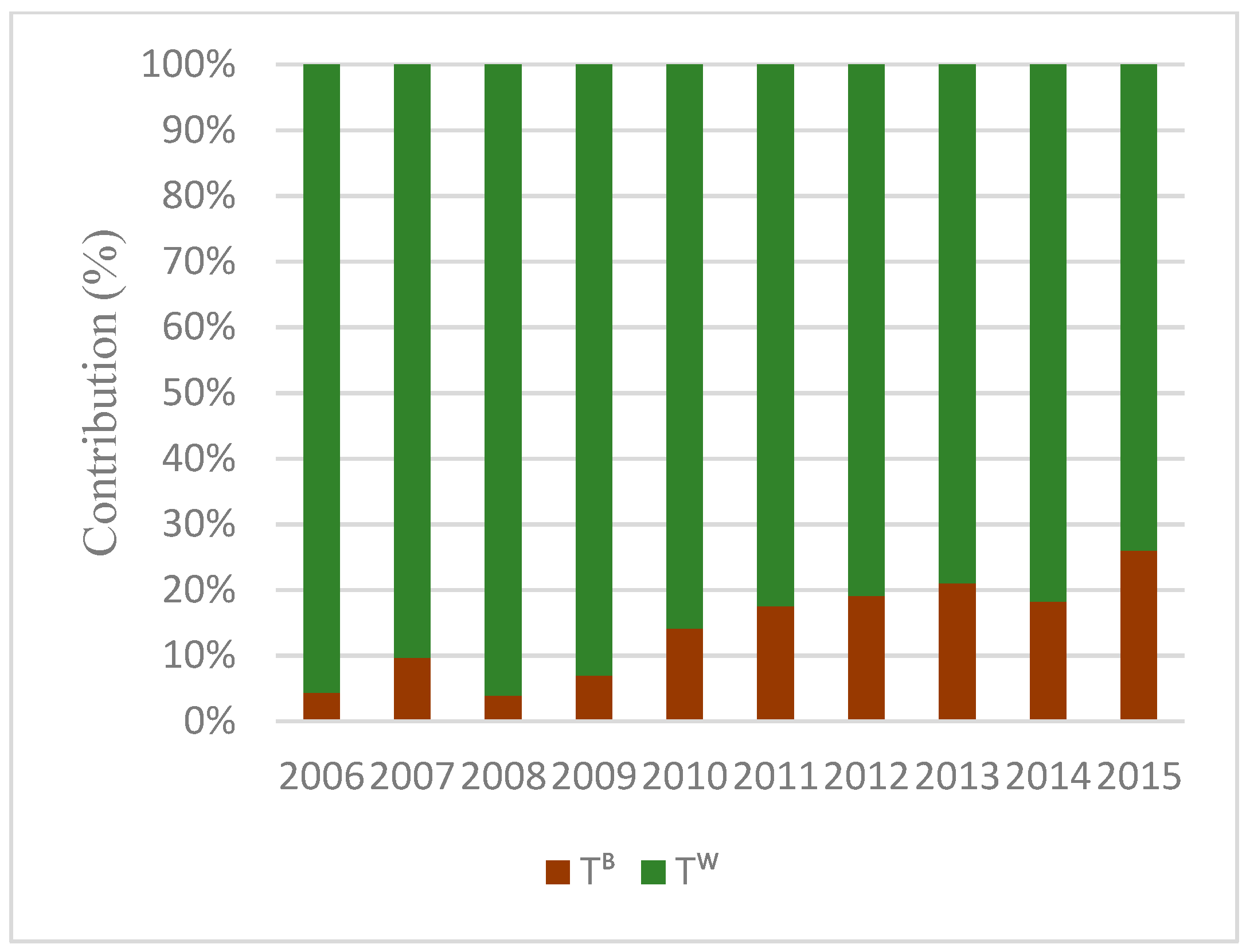
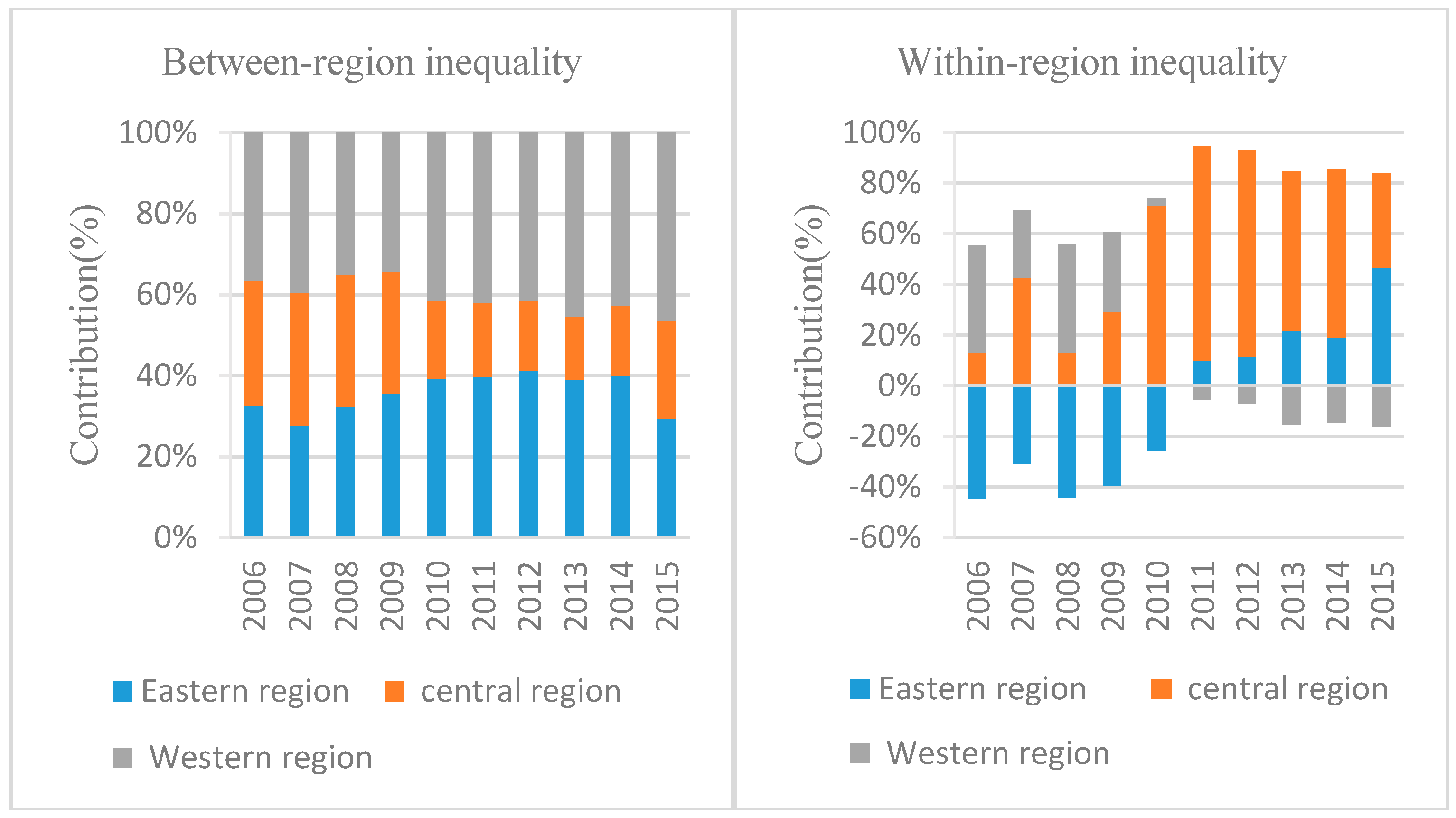
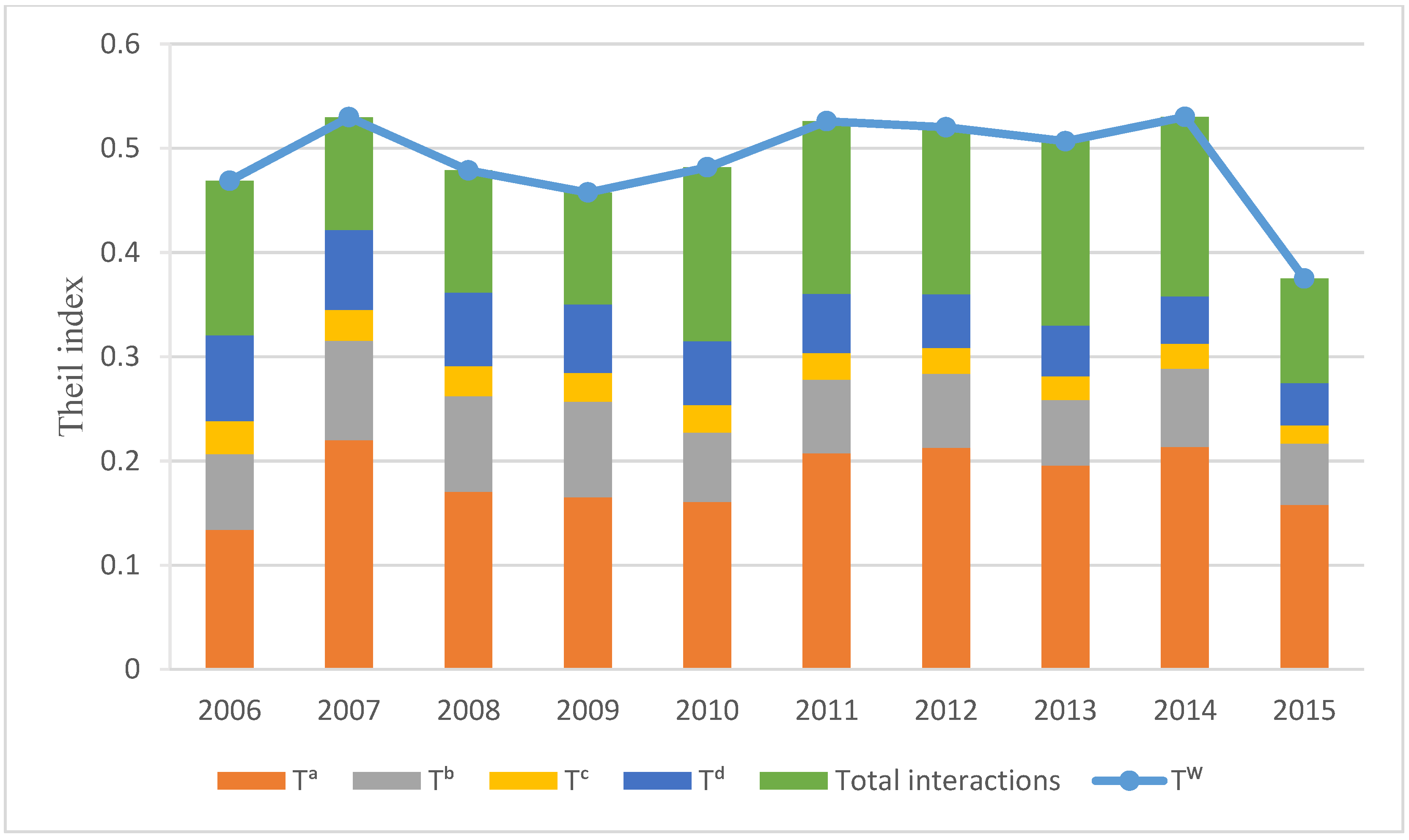
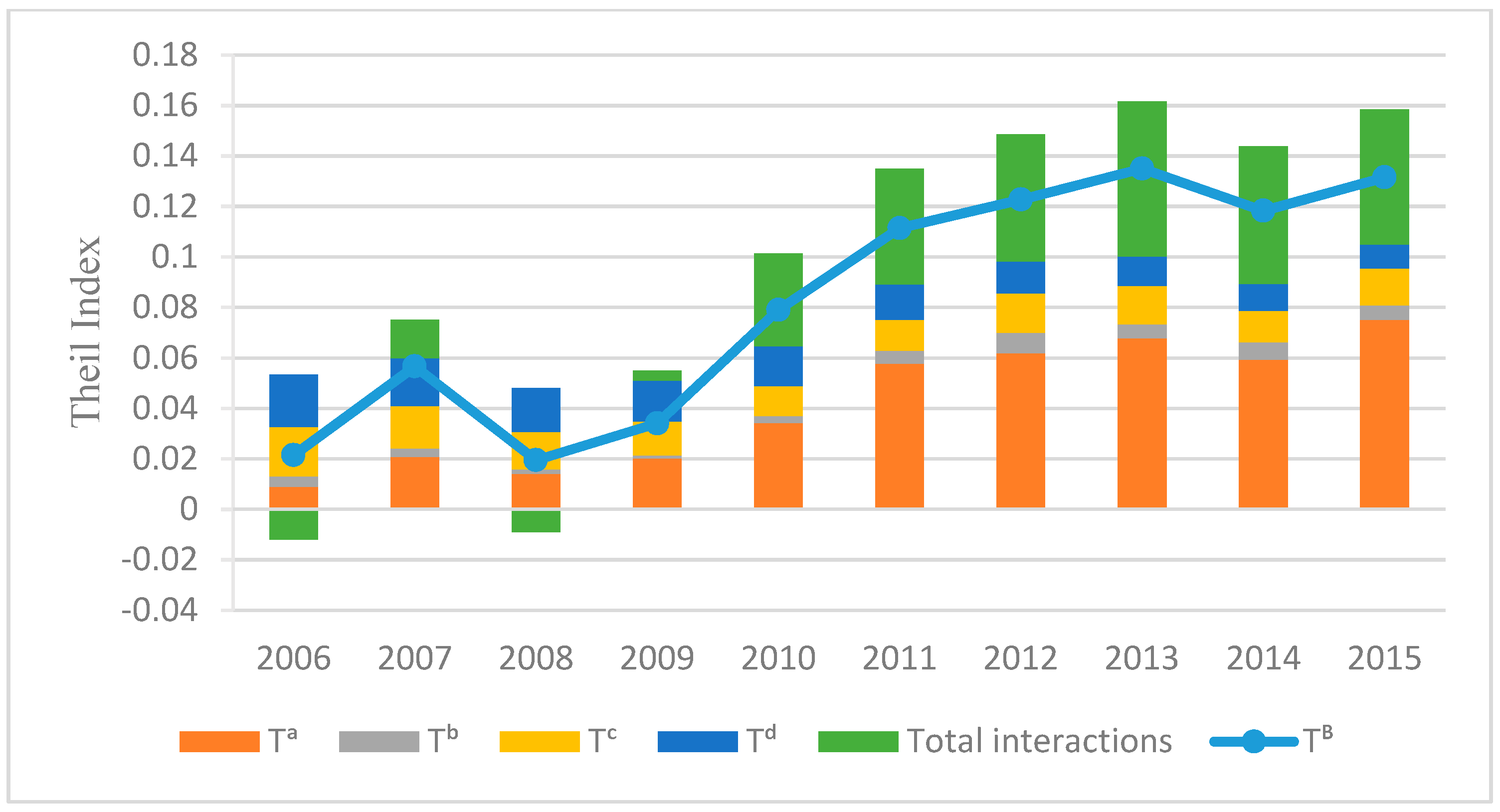
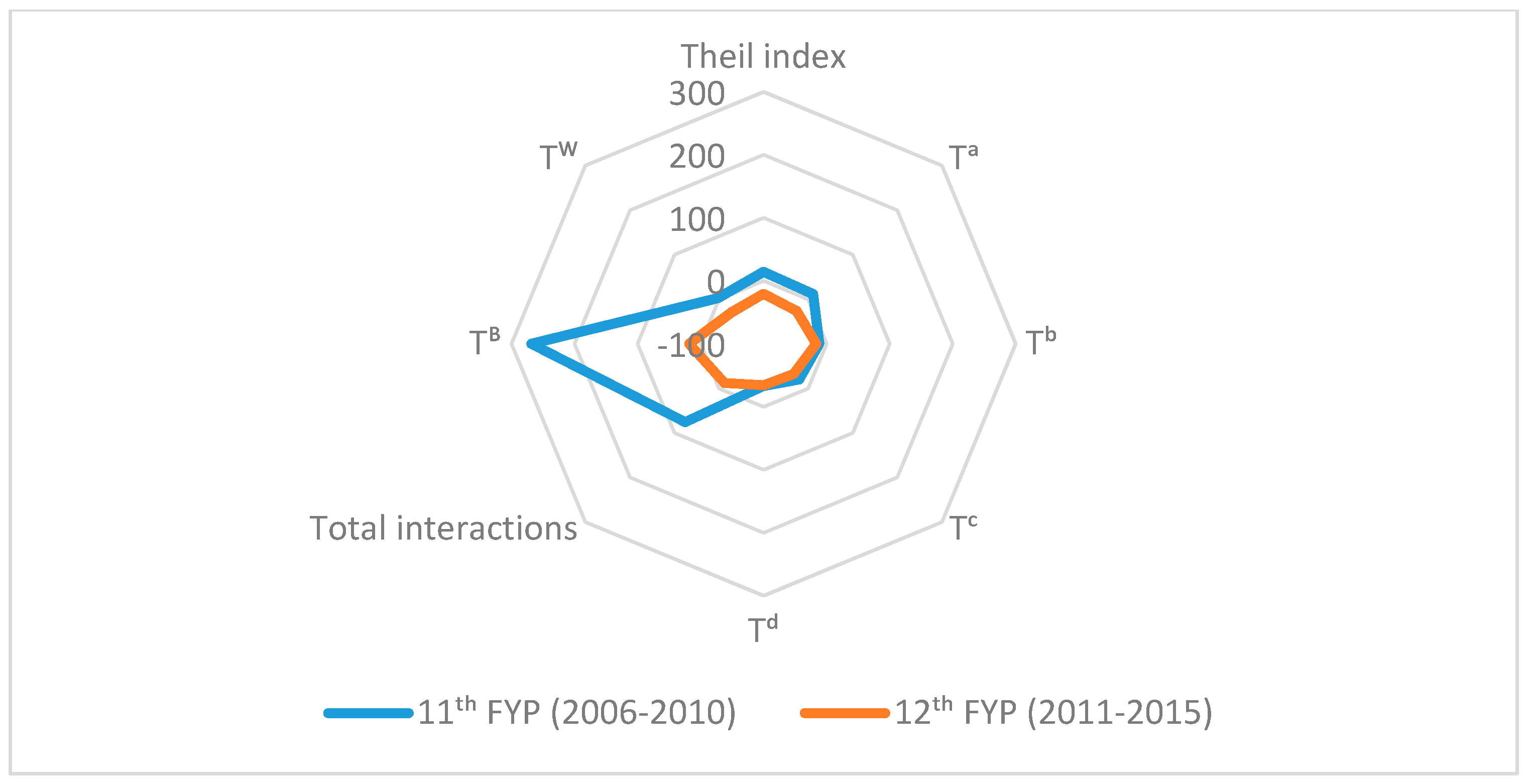
| Variable | Index | Factor | Unit |
|---|---|---|---|
| Air pollution | SO2, NOX | Emission | Ton |
| Cause | Economic | Coal consumption | 10,000 tons |
| Power generation | 100 million kWh | ||
| GDP | 100 million Yuan | ||
| Urban development | Gasoline consumption | 10,000 tons | |
| Transportation (Urban vehicles) | 10,000 units | ||
| Urban population | 10,000 persons |
| Year | Theil Index | (%) | (%) | (%) | (%) | (%) | (%) | (%) |
|---|---|---|---|---|---|---|---|---|
| 2006 | 0.5734 | 0.0780 (13.60) | 0.0673 (11.75) | 0.0999 (17.43) | 0.1596 (27.84) | 0.0248 (4.32) | −0.0077 (−1.34) | 0.1514 (26.41) |
| 2007 | 0.5569 | 0.0757 (13.59) | 0.0600 (10.77) | 0.1047 (18.81) | 0.1447 (25.99) | 0.0334 (5.99) | −0.0127 (−2.28) | 0.1511 (27.13) |
| 2008 | 0.5189 | 0.0760 (14.64) | 0.0662 (12.76) | 0.1024 (19.73) | 0.1329 (25.60) | 0.0230 (4.43) | −0.0184 (−3.54) | 0.1369 (26.38) |
| 2009 | 0.5276 | 0.0699 (13.25) | 0.0644 (12.20) | 0.1100 (20.86) | 0.1220 (23.12) | 0.0249 (4.72) | −0.0058 (−1.09) | 0.1422 (26.95) |
| 2010 | 0.5205 | 0.0675 (12.97) | 0.0656 (12.61) | 0.1032 (19.84) | 0.1059 (20.34) | 0.0337 (6.47) | −0.0093 (−1.79) | 0.1539 (29.57) |
| 2011 | 0.5199 | 0.0434 (8.36) | 0.0633 (12.17) | 0.1033 (19.87) | 0.0975 (18.75) | 0.0451 (8.67) | −0.0072 (−1.38) | 0.1745 (33.57) |
| 2012 | 0.5337 | 0.0392 (7.34) | 0.0658 (12.32) | 0.1135 (21.26) | 0.0918 (17.20) | 0.0298 (5.58) | −0.0012 (−0.22) | 0.1949 (36.52) |
| 2013 | 0.5389 | 0.0394 (7.31) | 0.0756 (14.02) | 0.1214 (22.52) | 0.0869 (16.12) | 0.0212 (3.94) | −0.0012 (−0.22) | 0.1957 (36.31) |
| 2014 | 0.5698 | 0.0429 (7.52) | 0.0894 (15.70) | 0.1369 (24.02) | 0.0839 (14.73) | 0.0239 (4.19) | −0.0032 (−0.56) | 0.1960 (34.41) |
| 2015 | 0.6070 | 0.0513 (8.45) | 0.1039 (17.11) | 0.1377 (22.69) | 0.0824 (13.57) | 0.0366 (6.03) | −0.0002 (−0.03) | 0.1953 (32.18) |
| Year | Theil Index | (%) | (%) | (%) | (%) | (%) | (%) | (%) |
|---|---|---|---|---|---|---|---|---|
| 2006 | 0.4902 | 0.1558 (31.78) | 0.0759 (15.48) | 0.0478 (9.75) | 0.0814 (16.61) | 0.0883 (18.01) | −0.0032 (−0.66) | 0.0443 (9.04) |
| 2007 | 0.5864 | 0.2305 (39.32) | 0.0992 (16.91) | 0.0471 (8.04) | 0.0735 (12.54) | 0.0939 (16.01) | 0.0060 (1.03) | 0.0361 (6.16) |
| 2008 | 0.4981 | 0.1962 (39.40) | 0.0931 (18.70) | 0.0455 (9.13) | 0.0658 (13.22) | 0.0673 (13.51) | −0.0051 (−1.03) | 0.0353 (7.08) |
| 2009 | 0.4915 | 0.1884 (38.33) | 0.0918 (18.69) | 0.0425 (8.64) | 0.0602 (12.25) | 0.0748 (15.22) | 0.0079 (1.61) | 0.0259 (5.27) |
| 2010 | 0.5606 | 0.1735 (30.95) | 0.0671 (11.96) | 0.0381 (6.80) | 0.0546 (9.74) | 0.2107 (37.58) | −0.0042 (−0.75) | 0.0208 (3.72) |
| 2011 | 0.6373 | 0.2310 (36.25) | 0.0710 (11.14) | 0.0372 (5.84) | 0.0490 (7.69) | 0.2396 (37.60) | −0.0084 (−1.31) | 0.0178 (2.79) |
| 2012 | 0.6428 | 0.2301 (35.79) | 0.0717 (11.15) | 0.0372 (5.78) | 0.0435 (6.76) | 0.2583 (40.18) | −0.0147 (−2.29) | 0.0169 (2.63) |
| 2013 | 0.6417 | 0.2081 (32.44) | 0.0639 (9.96) | 0.0335 (5.22) | 0.0400 (6.24) | 0.2939 (45.80) | −0.0132 (−2.06) | 0.0154 (2.40) |
| 2014 | 0.6483 | 0.2219 (34.23) | 0.0756 (11.67) | 0.0306 (4.72) | 0.0373 (5.75) | 0.2716 (41.89) | 0.0086 (1.32) | 0.0027 (0.42) |
| 2015 | 0.5064 | 0.1710 (33.76) | 0.0593 (11.71) | 0.0253 (4.99) | 0.0323 (6.37) | 0.1995 (39.39) | 0.0159 (3.13) | 0.0033 (0.64) |
© 2018 by the authors. Licensee MDPI, Basel, Switzerland. This article is an open access article distributed under the terms and conditions of the Creative Commons Attribution (CC BY) license (http://creativecommons.org/licenses/by/4.0/).
Share and Cite
Azimi, M.; Feng, F.; Yang, Y. Air Pollution Inequality and Its Sources in SO2 and NOX Emissions among Chinese Provinces from 2006 to 2015. Sustainability 2018, 10, 367. https://doi.org/10.3390/su10020367
Azimi M, Feng F, Yang Y. Air Pollution Inequality and Its Sources in SO2 and NOX Emissions among Chinese Provinces from 2006 to 2015. Sustainability. 2018; 10(2):367. https://doi.org/10.3390/su10020367
Chicago/Turabian StyleAzimi, Mohaddeseh, Feng Feng, and Yang Yang. 2018. "Air Pollution Inequality and Its Sources in SO2 and NOX Emissions among Chinese Provinces from 2006 to 2015" Sustainability 10, no. 2: 367. https://doi.org/10.3390/su10020367





